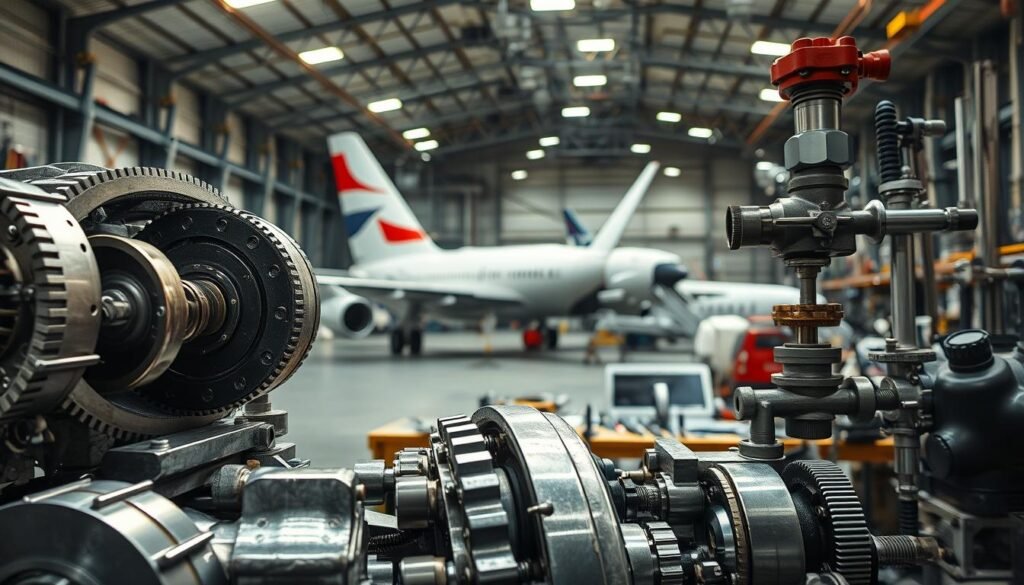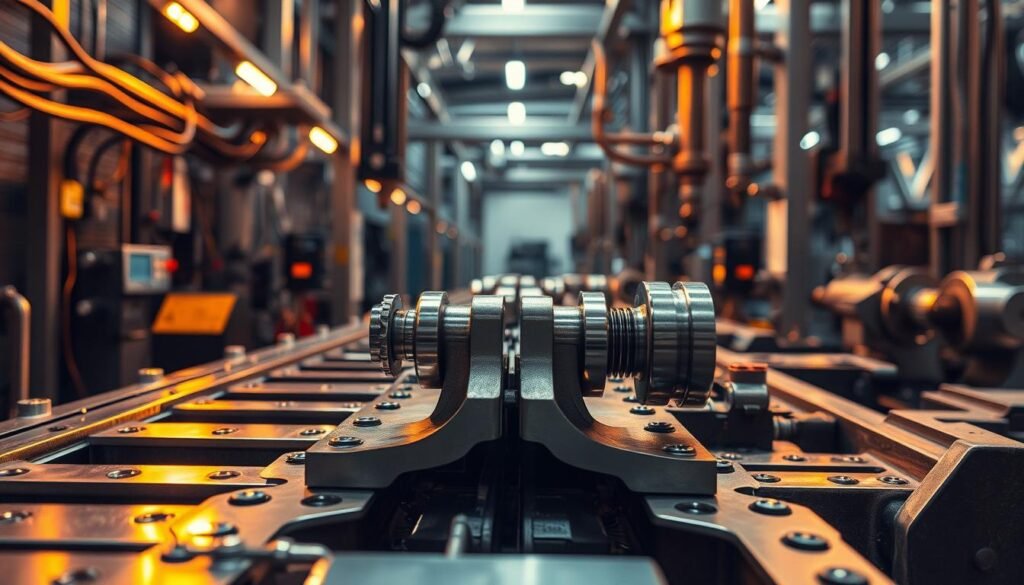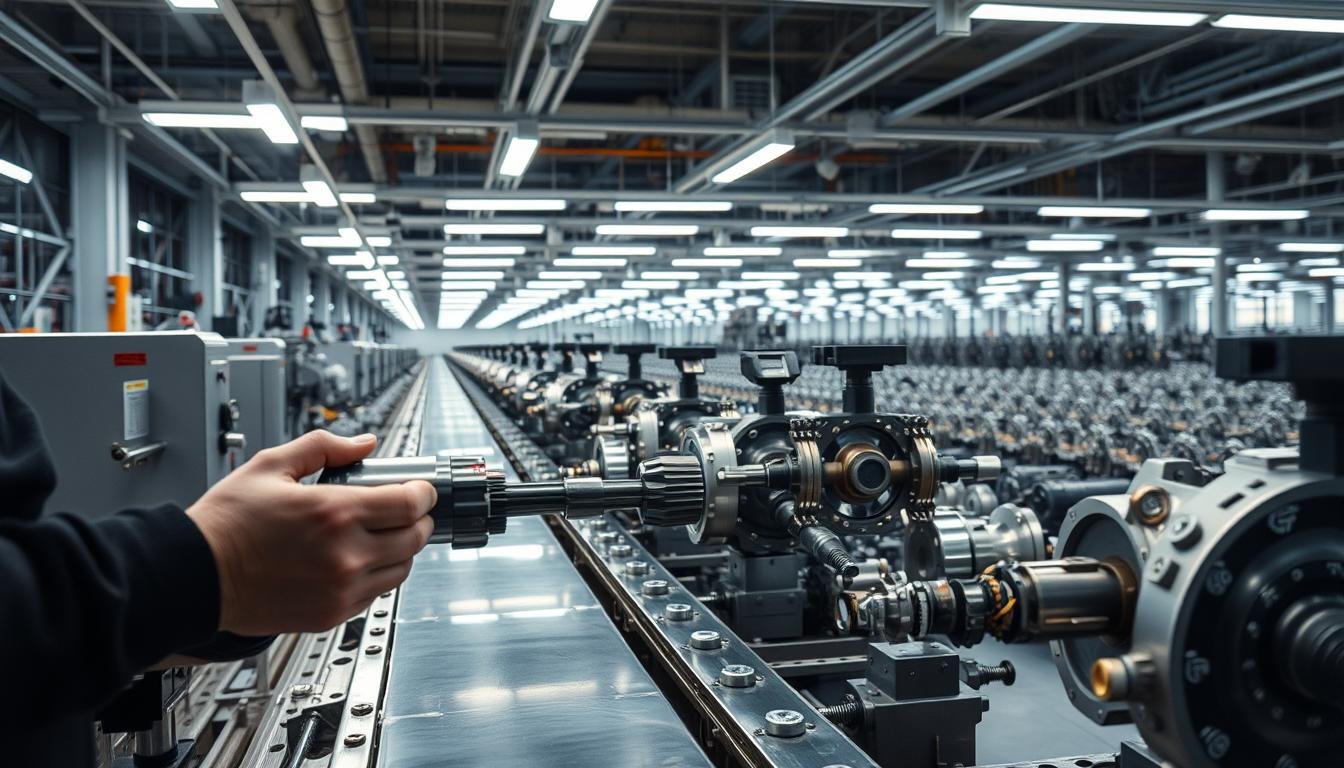In manufacturing, knowing how tolerances affect assembly is key. Tolerances make sure parts fit well, improving how they work. This leads to better products and happier customers.
We’ll look at how important tolerances are in fields like aerospace and cars. We’ll also see how cheap CNC machining helps get parts just right. This is crucial for making things work well together.
Principales conclusiones
- Dimensional tolerances are crucial for ensuring component compatibility and assembly efficiency.
- Industries like aerospace and automotive depend heavily on precise tolerances for product reliability.
- Affordable CNC machining services can achieve the necessary precision needed for high-performance assemblies.
- Understanding tolerances can significantly impact overall manufacturing efficiency and cost-effectiveness.
- Leveraging precision machining techniques aids in maintaining stringent tolerance requirements.
Understanding Dimensional Tolerances in Manufacturing
Dimensional tolerances are the allowed changes in part measurements. They are key for parts to fit right, work well, and meet design needs. These tolerances help keep products working well in many fields.
Definition and Importance of Tolerances
Tolerances are very important in making things. They show how much a part can be off from what’s expected. For example, metals can be off by ±0.005″ and plastics by ±0.01″. Knowing about tolerancias dimensionales helps make parts fit together right.
Role of Tolerances in Production Efficiency
Good tolerance management makes production better. Tighter tolerances might cost more but make assembly better. Using standards like Geometric Dimensioning and Tolerancing (GD&T) helps a lot. It makes production more efficient.
Adding bonus tolerance from Maximum Material Condition (MMC) also helps. It makes parts fit better and work better. To learn more, check out this recurso.
The Significance of Tolerances in Different Industries

Dimensional tolerances are key in many industries. They affect quality, safety, and how well things work. Each field has its own rules and standards. This ensures things are made right and work well.
Let’s look at how tolerances matter in aerospace, automotive, and electronics.
Aerospace Industry Standards
The aerospace world needs parts that are super precise. They must be made with great care. Even a tiny mistake can be very bad.
Parts must fit perfectly to keep flying safe. This high precision is a must. It makes sure planes are safe to fly.
Automotive Industry Requirements
Car parts need to fit just right. This keeps them working well. If parts don’t fit, cars can break down.
By following strict standards, cars last longer. They need less fixing. This shows how important precise engineering is.
Electronics and Their Precision Needs
Electronics need to work well together. Parts must fit perfectly. This keeps them working right.
Even a little bit of variation can be a problem. But, making things too perfect can be expensive. Finding the right balance is key. This lets makers create electronics that people want.
How Tolerances Affect Assembly Performance

Tolerances are key to great assembly performance. They control how well parts fit and work together. This affects the quality of the final product.
Impact on Component Fit and Functionality
Right tolerances mean parts fit perfectly. A tiny mistake, like a hole being too small, can mess up the assembly. This can cause problems and even failures.
CNC machining helps manage these tolerances well. It’s very important in fields like aerospace and cars. Here, the tolerances effect on assembly performance is crucial for safety and success.
Influence on Overall Product Quality
The quality of a product depends on how well its parts fit. Parts made with tight tolerances last longer and work better. If tolerances are off, quality issues can arise.
Utilizando tolerance management guidance helps plan and do better. This improves product performance and quality for customers.
Dimensional Tolerances and Manufacturing Costs

The link between dimensional tolerances and manufacturing costs is complex. Precision in production can lead to big financial wins or losses. Knowing this helps manufacturers make smart choices to boost efficiency and profits.
Balancing Cost and Precision
Finding the right mix of cost and precision is key. Tighter tolerances can improve product quality but raise costs. The effects of tolerances on costs include:
- Higher material costs due to scrap rates.
- Increased labor expenses from skilled technicians handling intricate processes.
- Investment in advanced machinery capable of achieving fine tolerances.
By focusing on precision, businesses can meet quality standards without breaking the bank.
The Cost of Reworks and Quality Control
Rework costs can be a big problem if products don’t meet tolerances. Quality control steps are vital to cut these costs. The cost of quality control includes:
- Regular inspections and audits to ensure adherence to tolerances.
- Investments in technologies that enhance measurement accuracy.
- Training employees to recognize and mitigate tolerance-related issues.
Knowing these costs helps with better budgeting. It shows the value of keeping tolerances right in manufacturing. As we aim for better production, focusing on effective tolerances is key.
Strategies for Managing Dimensional Tolerances
Managing dimensional tolerances is key in making products. It makes sure parts fit right and work well. We use different ways to balance being precise and fast.
Implementing Automated Measurement Systems
Automated systems are very important for managing tolerances. They collect and analyze data fast, cutting down on mistakes. This makes our products better and saves time.
Leveraging Precision Machining Techniques
Precision machining is crucial for tight tolerances. Methods like CNC machining help make parts just right. New machines and methods make our work better and faster.
Continuous Employee Training and Development
Training employees is vital for quality. It teaches them about tolerances and how to use new tools. This makes our team better at making precise products.
| Estrategia | Descripción | Beneficios |
|---|---|---|
| Automated Measurement Systems | Real-time data collection reduces inspection errors. | Enhances accuracy, minimizes downtime. |
| Precision Machining Techniques | Utilizes advanced methods to create tight tolerances. | Increases production efficiency, maintains quality. |
| Continuous Training | Regular skill enhancements for staff. | Ensures knowledge retention, improves workforce competency. |
How Tolerances Enhance Product Quality

Tolerances are key to making sure products are top-notch. By using smart tolerance strategies, makers can boost product quality and make customers happy. This focus on precision makes products better and builds a strong reputation for quality.
Regaining Customer Trust through Reliability
Meeting product standards builds trust with customers. Precision engineering makes products reliable, which is what people want. Keeping tight tolerances means products last longer and work better, keeping customers coming back.
Reducing Warranty Claims and Defects
Lowering defects saves money. Good tolerance management cuts down on mistakes, which means fewer warranty claims. This leads to more money saved and a stronger brand image.
For exacting quality, look to experts in mecanizado de precisión. Companies like United CNC Machining offer top-notch solutions. They help achieve tight tolerances and high-quality products, giving you an edge in the market.
Affordable CNC Machining Services and Tolerance Control
In the world of making things, it’s key to find a balance between cost and quality. Affordable CNC machining helps keep costs down while still meeting high standards. This way, companies can stay within their budget while still making top-notch products.
Precision CNC Machining for Tight Tolerances
Getting things just right is crucial, and CNC machining helps a lot. Tight tolerances can make things more expensive. For example, ultra-precision work can cost a lot because it needs special tools.
Prices vary based on the type of CNC machine. 3-axis machines cost between $5 and $15 an hour. But 4- or 5-axis machines can be $15 to $25 an hour. These prices affect how precise and efficient your work can be.
Benefits of Low-Cost CNC Machining Solutions
Going for cheaper CNC options lets companies use new tech without spending too much. Materials like aluminum 6061 are easier to work with, saving money. This is better than harder materials like stainless steel 303.
Also, making more parts at once can cut costs a lot. For example, making 1,000 parts can save up to 66.79% compared to making just one. This helps companies keep quality high while saving money.
Overcoming Challenges in Tolerance Management
In manufacturing, tackling tolerance management challenges is key for better efficiency and quality. Managing dimensional tolerances is complex, mainly due to conflicting tolerances and over-specification. An integrated approach, using technology and quality control, is needed to overcome these hurdles.
Technological Advancements in Tolerance Control
New technology has changed how we manage tolerances. For example, tolerance analysis software is vital in spotting design flaws early. It helps lower costs by:
- Finding design flaws that could cause production mistakes.
- Lowering scrap and material waste with better tolerances.
- Making assembly more efficient with clearer specs.
- Improving communication with suppliers for smoother operations.
- Supporting ongoing quality control efforts.
Thanks to technology, companies can better manage tolerances. This leads to faster production, less inventory costs, and more precise parts.
Quality Control Measures in Place
Effective quality control is crucial for managing dimension tolerances. A good quality control system includes:
- Regular training on GD&T for employees.
- Using advanced tools for precise part measurements.
- Setting up clear communication to avoid tolerance mistakes.
These steps help avoid expensive errors and misinterpretations in complex specs. By focusing on these practices, companies can reduce risks and improve product reliability and performance.
Conclusión
We’ve looked at how tolerances affect assembly performance. We see how important managing tolerances is for better product quality and work efficiency. Tolerances are key in making things fit right and keeping costs down.
Using cost-effective machining and smart strategies helps manufacturers deal with tolerance issues. This way, they can meet and even beat customer needs. Our insights also show the need to keep improving precision and quality as standards rise.
Having a strong plan for tolerances helps manufacturers stay ahead in a tough market. The key is to focus on doing things right and with precision. This is what will make us succeed in the future.
PREGUNTAS FRECUENTES
What are dimensional tolerances in manufacturing?
Dimensional tolerances are the allowed changes in part sizes. They make sure parts fit right and work well together.
Why are dimensional tolerances significant in different industries?
Tolerances matter a lot in fields like aerospace, automotive, and electronics. Each has its own rules and problems that affect how parts fit and work.
How do tolerances impact assembly performance?
Tolerances affect how parts fit together. This, in turn, impacts the quality and reliability of the final product.
What is the relationship between tolerances and manufacturing costs?
Tolerances and costs are closely linked. Tight tolerances might raise production costs. But, managing them well can keep costs down and improve product quality.
What strategies can be employed to manage dimensional tolerances?
To manage tolerances, use automated measurement tools and precise CNC machining. Also, train employees to follow tolerance rules closely.
How do affordable CNC machining services contribute to tolerance control?
Cheap CNC machining services offer precise work at a good price. This lets makers hit tight tolerances without losing quality.
What challenges are involved in mastering tolerance management?
Mastering tolerances is tough. It means keeping up with new tech, ensuring quality, and focusing on precision all the time.
How can proper management of dimensional tolerances enhance product quality?
Good tolerance management boosts product reliability and cuts down on defects. This builds customer trust and lowers warranty claims.


